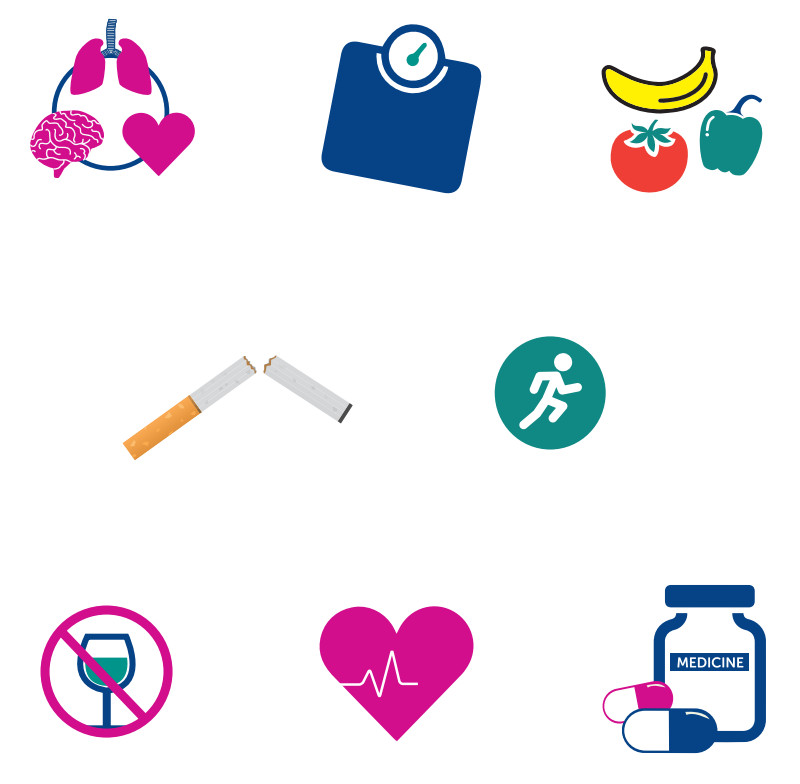Where there is a confirmed diagnosis of a new ischaemic stroke / TIA the patient’s cardiac rhythm should be determined.
- An ECG will determine the presence of an abnormal cardiac rhythm such as atrial fibrillation (AF)
- Prolonged cardiac monitoring may be required for some patients
- A patient in sinus rhythm would normally be prescribed antiplatelet drugs
- A patient in AF or paroxysmal AF should be considered for anticoagulant drugs
- Where there is a risk of bleeding a patient in AF or paroxysmal AF may be prescribed antiplatelet drugs

Clinical diagnosis of new acute stroke
Once a diagnosis of TIA or stroke has been made investigations are performed to determine the potential underlying causes.
After an ischaemic stroke or TIA treatments would usually include antiplatelets or anticoagulants.
After a haemorrhagic stroke management is usually focused on identifying and treating the underlying cause.
Brain imaging is performed to differentiate between ischaemic and haemorrhagic stroke.
Occasionally brain imaging is used after TIA for a similar reason.
Most patients require standard preventative treatments.
Some rare causes will need specific treatments e.g. antibiotics for bacterial endocarditis, steroids for giant cell arteritis.
The red men represent people having strokes.
This graphic demonstrates that without receiving appropriate treatment and secondary prevention: 10 people will have a stroke in the 7 days after a TIA – a 10% risk. The daily risk of stroke falls over the next few months. About another 5 people (5%) will have a stroke between 7 and 30 days, another 5% between 30 days and 90 days and another 5% between 90 days and the end of the first year. Therefore, 25 (25%) will have a stroke over the first year but most occur in the early period.
For further information on understanding risks see Topic Loop below.
Topic Loop:
- It is important to understand what we mean by risk of stroke
- Some people prefer to talk about the chances of having another stroke
- Often people simply talk about the risk being high (an absolute risk) or higher than another group who have not had a TIA or stroke (a relative risk)
- We need to understand how high the risk is (e.g. 10 % in the first week) – this is an absolute risk
- How many times higher the risk is (e.g. 100 times the risk compared with a person who has not had a stroke/TIA) – this is a relative risk
For further information on understanding risks see Topic Loop below.
Topic Loop:

Module Authors
Please note that the group have reviewed and updated all Topic Loops related to STARS AM 9 (April 2022)
Module lead
Dr. Richard O’Brien, Consultant Physician, Stroke Medicine & Medicine of the Elderly, NHS Lothian
Group members
Dr. Anne Rowat, Senior Lecturer, Nursing & Health Care School, University of Glasgow
Katrina McCormick, Clinical eLearning Project Manager, Chest Heart & Stroke Scotland
Stuart McCormick, Registered General Nurse
Serena Battistoni, eLearning Interactive Content Developer, Chest Heart & Stroke Scotland
This module was originally developed by:
Group Lead: Dr Simon Hart, Consultant Physician, NHS Lothian
Group Members: Prof Martin Dennis, Professor of Stroke Medicine, University of Edinburgh
Hazel Fraser, Stroke Coordinator, NHS Fife
Billy Laing, Pharmacist, NHS Lanarkshire
Dr Maggie Lawrence, Research Fellow, Glasgow Caledonian University
Kate McDermott, Stroke Liaison Nurse, NHS Lanarkshire
Morag Ogilvie, Specialist Dietitian, NHS Forth Valley
Gillian Paton, Senior Speech & Language Therapist NHS Greater Glasgow & Clyde
Critical Readers: Anne-Marie Irving, Speech & Language Therapy Manager, NHS Forth Valley
Dr Stuart Johnston, Consultant Physician, NHS Tayside
Katie Lambert, Stroke Nurse, CHSS / NHS Lothian
Ceirwen Roberts, Staff Nurse, NHS Lothian
Dr Anne Rowat, Lecturer, School of Nursing, Midwifery & Social Care, Napier University
This module focuses on reduction of risk of further stroke in patients with TIA and stroke. This is because secondary prevention is an important aspect of their management. For some patients other aspects of care will often dominate management e.g. treatment of complications, rehabilitation and long term support. It is important to ensure that each patient has individualised care depending on their needs. In this module we present approximate figures in referring to risks of stroke and benefits of treatment for the sake of simplicity and clarity. There are many estimates of these figures in the literature which have varied from research study to research study.
The answers to all the test questions are contained within the module. This information may be provided in the ‘Additional Information’ boxes on some of the pages and in the ‘Topic Loops’. Please note that with the addition of the Topic Loops, it is advisable to allow yourself more time to complete this module. Remember, you do not have to complete the whole module at one sitting, you can, for example, do one patient scenario per visit to the website.
References
- Mitchell. P.H., Veith, R. C., Becker, K. J., Buzaits, A., Cain, K.C., Fruin, M., Tirschwell, D., & Teri, L. (2009). Brief Psychosocial-Behavioral Intervention With Antidepressant Reduces Poststroke Depression Significantly More Than Usual Care With Antidepressant. Living Well With Stroke: Randomized, Controlled Trial. Stroke. 2009;40:3073
- Robinson, R.G., Jorge, R.E., Moser, D.J., Acion, L., Solodkin, A., Small, S. L., Fonzetti, P., Hegel, M., & Arndt, S. (2008). Escitalopram and Problem-Solving Therapy for Prevention of Poststroke Depression A Randomized Controlled Trial. JAMA. 2008; 299(20):2391-2400.
- Watkins, C.L., Auton, M.F., Deans, C.F., Dickinson, H.A., Jack, C.I.A., Lightbody, E., Sutton, C.J., van den Broek, M.D., Leathlety, M.J..(2007). Motivational Interviewing Early After Acute Stroke: A Randomized, Controlled Trial. Stroke. 2007;38:1004-1009
- Spiritual Care Matters: An Introductory Resource for all NHS Scotland Staff [PDF, 2.02MB]
- SIGN 118 (2010). Management of Patients with Stroke: Rehabilitation, Prevention and Management of Complications, and Discharge Planning
- RCP (2016) National Clinical Guideline for Stroke, 5th Edition
Further reading
These are useful resources that are not specifically cited within the module:
- BPS Briefing Paper No 19 (2010). Psychological Services for Stroke Survivors and their Families. British Psychological Society: Leicester.
- Hackett, M.L., Anderson, C.S., House, A., & Halteh, C. (2008). Interventions for preventing depression after stroke. Cochrane Database of Systematic Reviews 2008, Issue 3. Art. No.: CD003689. DOI: 10.1002/14651858.CD003689.pub3.
- Hackett, M.L. Anderson, C.S., House, A., & Xia, J (2008). Interventions for treating depression after stroke. Cochrane Database of Systematic Reviews 2008, Issue 4. Art. No.: CD003437. DOI: 10.1002/14651858.CD003437.pub3.
- House, A. (2003). Defining, Recognizing and Managing Depression in Neurological Practice. Practical Neurology, 3, 196-203.
- McSherry, W. (2006). Making Sense of Spirituality in Nursing and Healthcare Practice, an interactive approach. Second Edition, Publ: Jessica Kingsley, 2006, ISBN-13: 978 1 84310 365 3.
- NHS Education for Scotland. (2006). A Multi-Faith Resource for Healthcare Staff [PDF]
- HealthScotland (2008). Religion and Belief Matter: An Information Resource for Healthcare Staff [PDF]
Copyright Issues
Scored examples of the GHQ-12 & HADS have been used within the module for illustrative purposes. They are reproduced with the kind permission of GL Assessment, The Chiswick Centre, London.
A scored example of the PHQ-9 has been used within the module and has been reproduced with the kind permission of Kurt Kroenke, MD, Professor of Medicine, Indiana University, Regenstrief Institute, Indianapolis.

Mood and emotion after stroke
The following people are talking about the effect on mood and emotions after stroke and how psychology helped them to overcome these issues. Click through the slides using the ◂▸ controls underneath.





